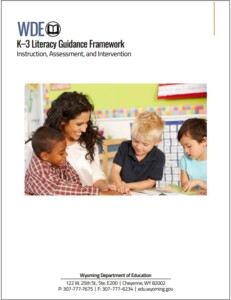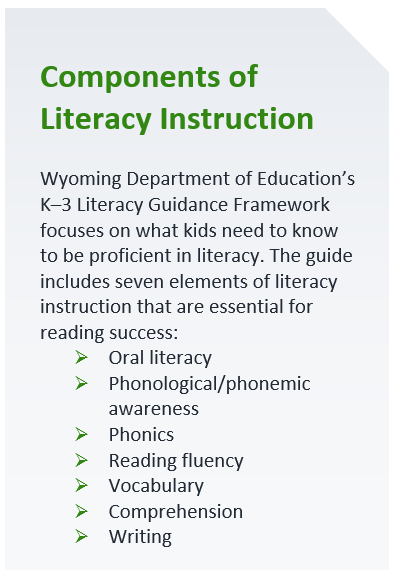The Wyoming Department of Education (WDE) and the Region 11 Comprehensive Center (R11CC) have been hard at work providing statewide supports and guidance to improve elementary students’ literacy skills, while also honoring the autonomy individual schools and districts have regarding their instructional decisions.
Improving student literacy has long been a focus in Wyoming, even prior to the 2019–2024 R11CC cycle. However, in the current cycle, the WDE prioritized building relationships and capacity, overhauling the state’s literacy framework, and conducting an implementation pilot project at two school districts in collaboration with the University of Wyoming’s Literacy Research Center and Clinic (UW LRCC).
Collaboratively Crafting the Guidance Framework
 While Wyoming has reading standards, it does not dictate curriculum or common assessments for its schools and districts. With this project, the WDE sought to define expectations for the use of evidence-based resources and highlight available supports that can help improve teacher practice. As a first step, the WDE–R11CC partners began overhauling the state’s existing literacy guidance. In 2021 they published the WDE K–3 Literacy Guidance Framework.
While Wyoming has reading standards, it does not dictate curriculum or common assessments for its schools and districts. With this project, the WDE sought to define expectations for the use of evidence-based resources and highlight available supports that can help improve teacher practice. As a first step, the WDE–R11CC partners began overhauling the state’s existing literacy guidance. In 2021 they published the WDE K–3 Literacy Guidance Framework.
“It’s a foundational guidance document where we’re trying to develop a common understanding and a common language across the state,” said Shelley Hamel, WDE’s chief academic officer. “We can’t require [schools to use] it, but it aligns really well to our statutory requirements, and we anticipate the document will be part of our state literacy plan ongoing.”
Joe Simpson, the R11CC co-director and Wyoming project lead, invited a group of national literacy consultants to assist staff from the R11CC, the UW LRCC, and the WDE in writing the K–3 literacy framework.
“We had a desire to really get this right, and a big takeaway for me was that the R11CC could make connections that would be more complicated for a state itself to make,” said Hamel. “I could have called around but knowing who the right person at the university level outside of our state, or who the expert was for English as a second language learner, would have been much more time consuming.”
After the K–3 literacy framework was drafted, the WDE–R11CC partners facilitated a practitioner committee that collaboratively reviewed the document page by page before approving it. The review committee was made of a mix of teachers, curriculum directors, coaches, and reading specialists from small, medium, and large school districts.
“It was neat to be a part of because it involved a diverse group of people coming together and bringing different expertise,” said Sara McGinnis. At the time, McGinnis served on the review committee in her role as curriculum director for Sheridan County School District #1. Later, after retiring from the district, she joined the R11CC and continued supporting the work.
The K–3 literacy framework presents best practices for reading instruction, but to respect school choice it steers clear of endorsing one approach to reading over another. “We reached out to the national experts to capture the latest research on literacy instruction,” said Simpson. “But the framework is unique to Wyoming due to statutory guidance, WDE policy, and educator training. The sections were developed with the Wyoming context in mind and is useful regardless of curriculum used or previous training.”
Research shows that early literacy has profound implications on a student’s overall achievement, and that proficiency by the end of third grade is an indicator of future academic success as instruction shifts from learning to read to reading to learn, according to the International Dyslexia Association.
“Early identification and instruction aimed at addressing potential reading difficulties is the key to preventing prolonged difficulties in learning to read and ensuring that all students are reading with proficiency by the end of third grade,” the K–3 literacy framework states in its introduction. From there, the framework is divided into sections covering literacy instruction, indicators of reading difficulties, Wyoming’s Multi-Tiered Systems of Support (MTSS), and selecting evidence-based resources.
 The literacy instruction section focuses on what kids need to know to be proficient in seven strands of literacy. The section about indicators of reading difficulties includes guiding questions to address possible processing and recognition difficulties—and the WDE recently published a companion guide specific to dyslexia.
The literacy instruction section focuses on what kids need to know to be proficient in seven strands of literacy. The section about indicators of reading difficulties includes guiding questions to address possible processing and recognition difficulties—and the WDE recently published a companion guide specific to dyslexia.
The MTSS section discusses Tier 1, 2, and 3 practices and strategies, which was important to include because schools are required to have intervention approaches by Wyoming law, Simpson said. And the section on selecting evidence-based resources empowers educators with the background knowledge necessary to find good classroom resources, rather than the WDE dictating specific resources or assessments they must use.
The sweeping K–3 literacy framework is designed to meet schools where they are and support instructional improvement. To determine the best place to begin, Simpson strongly encourages schools to conduct a comprehensive needs assessment that specifically looks at each of the framework sections. “Because really, if you’re going to improve literacy, you have to have these four things in place; you have to have literacy instruction, intervention approaches for reading difficulties, multi-tiered systems of support, and a process for selecting evidence-based, not research-based, resources,” he said. After reviewing their needs assessment results, a school team can then determine where to focus first to change teacher performance.
Piloting Implementation
After creating the K-3 literacy framework, the WDE–R11CC partners developed pilot project to support its implementation.
The partners agreed that it was important for schools and teachers to want to engage in the pilot. Recruitment started with districts self-selecting to participate. “That’s an important piece. If the state said, ‘You will be in this,’ it wouldn’t have gone anywhere,” explained Simpson. “From the very beginning, we wanted self-selection, continual engagement, and co-development.”
Supporting Tribal districts was also a priority for the WDE. “They’ve been the bottom 5% of our school district performance year after year for as long as I can remember,” said Hamel. “We know literacy is a foundational skill for all learners. It’s one of those critical predictors of our long-term health and earning capacity, and life in general. So, we wanted to find some way to start to move the needle.”
After traveling the state to make presentations, and quite a bit of follow up, two schools volunteered to participate: Arapahoe Elementary School and Wind River Elementary School, both of which serve large percentages of Native American students. Staff from the UW LRCC, which had contributed to the development of the K–3 literacy framework, took on a large role in working with both schools. The UW LRCC conducted a comprehensive needs assessment with each school with questions aligning to each section of the K–3 literacy framework. After each school reviewed the findings, the schools’ principals and teachers determined which strand of literacy instruction from the K–3 literacy framework they would focus on during the pilot. Wind River selected vocabulary, and Arapahoe selected writing.
With the needs assessments completed (in 2021 for Arapahoe and 2022 for Wind River), the UW LRCC–R11CC team began conducting on-site professional learning sessions six times a year at each school, using instructional strategies identified in the K–3 literacy framework. At Arapahoe, professional learning initially focused on evidence-based strategies and evolved into collaborative planning meetings with individual teachers focused on lesson planning and graphic organizers. In addition, a K–5 writing curriculum aligned with the Wyoming State Content Standards was co-developed with the Arapahoe Elementary staff and the R11CC, and individual teachers received coaching on different forms of writing as outlined in the K–3 literacy framework. At Wind River, the UW LRCC–R11CC team facilitated a schoolwide book study, reading Bringing Words to Life: Robust Vocabulary Instruction by Isabell Beck, Margaret McKeown, and Linda Kucan to enhance teachers’ knowledge of vocabulary strategies identified in the framework. Then, mirroring the K–3 literacy framework structure, Wind River developed a comprehensive vocabulary framework to support vocabulary instruction.
The R11CC also created knowledge management sites to house the evidence-based literacy resources curated and created for each school. The knowledge management sites will be managed by the schools after the project wraps to support sustainable long-term use and continued alignment with the K–3 literacy framework. “The creation of the resources, and to have those resources accessible and in place for the schools when this project comes to an end, really builds ongoing capacity,” said Hamel. “It was really impressive.”
Moving Forward
Capacity and relationship building have been at the heart of this project. From the beginning, there was a focus on building relationships within the state to enshrine trust and ensure that the work will continue long after the grant ends. It also was about striking a balance that gives choices but provides clear expectations.
“This work is a celebration for WDE,” McGinnis said. “As our guiding instructional leaders, their job is not to dictate curriculum or resources in schools, but to support literacy development in our schools.”
The K–3 literacy framework is a good step to accomplish this goal. “I think the power of this project is the state has a clear focus on what literacy should look like in every district in order to improve teacher practices,” Simpson said. “This gives them that clear guidance.”
Building off the momentum of the K–3 literacy framework and the school pilots, the WDE is now focusing on the power of instructional coaching. The WDE is awaiting word on another federal literacy grant to implement coaching hubs and continue to build out district and regional capacity, Hamel said. “Region 11 was a really good partner in working to grow capacity at both of those two sites,” Hamel said. “The coaching component that was afforded to those two [pilot] school sites was just incredible. It reinforced our belief at the agency that ongoing coaching is critical to building trusting relationships.”
At the end of the project, forging stronger relationships and building capacity within the state will benefit Wyoming students. “We often try to accomplish work on our own; sometimes we reach out, but not as often as we should,” said Hamel. “Just recognizing the amount of support that the regional centers can offer was a really big ‘aha’ for me.”
Contact
For more information about the work being done in Nebraska, please contact R11CC co-directors Susan Shebby and Joe Simpson.
